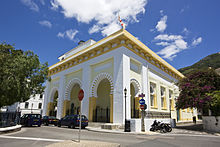Cathedral of the Holy Trinity, Gibraltar
| Cathedral of the Holy Trinity | |
|---|---|
| Gibraltar Cathedral | |

Main entry of the Cathedral of the Holy Trinity in Gibraltar viewed from Cathedral Square, depicting its Moorish-style horseshoe arches.
|
|
| 36°08′18″N 5°21′15″W / 36.138235°N 5.35406°WCoordinates: 36°08′18″N 5°21′15″W / 36.138235°N 5.35406°W | |
| Location | Cathedral Square |
| Country |
|
| Denomination | Church of England |
| Website | Holy Trinity |
| History | |
| Founder(s) | John Pitt, Earl of Chatham |
| Architecture | |
| Architect(s) | Unknown |
| Style | Moorish Revival |
| Administration | |
| Diocese | Diocese of Gibraltar in Europe |
| Clergy | |
| Dean | John Paddock |
| Chaplain(s) | Assistant Chaplain and Port Chaplain: Vacancy |
The Cathedral of the Holy Trinity is the cathedral for the Church of England Diocese of Gibraltar in Europe. Located in Cathedral Square, it is sometimes referred to simply as Gibraltar Cathedral, although it should not be confused with the Cathedral of St. Mary the Crowned, which is Gibraltar's Roman Catholic cathedral. The cathedral is particularly notable for its Moorish revival architecture, particularly in its use of horseshoe arches. This is an architectural style inspired by Moorish architecture, appropriate given the period of Moorish control in Gibraltar's history.
The church was originally built to meet the needs of Anglican worshippers among the civil population of Gibraltar, as the King's Chapel was primarily reserved for military use. John Pitt, Earl of Chatham, who had arrived as Governor of Gibraltar in 1820, persuaded the British Government to sell a derelict building and use the money to build a church on the land.
Building work began in 1825 and the church was completed in 1832. The architect is unknown; Colonel Pilkington of the Royal Engineers was in charge of the work. During the building process, the partially completed church had to be used for a short time as an emergency hospital during an epidemic of Yellow Fever.
...
Wikipedia
